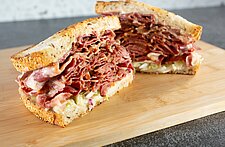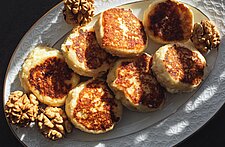By Chef Ron Spaziani
Peruvian food is among one of the most varied and geographically based cuisines in the world. It’s no big surprise that there are four times more Peruvian restaurants than there were 10 years ago. More and more people are exploring the endless food culture of this country and rightfully so. Peru has become a foodie’s dream destination because of the diverse culinary regions. “Fifteen years ago, Peruvian cuisine was unknown,” said Mariano Valderrama, vice president of Peru’s Gastronomic Association (APEGA). “Now it’s in fashion, and Peru is positioning itself globally as a first-class tourist and gastronomic destination.”
Four main regions make up the majority of traditional Peruvian cuisine. The coastal region, which is by far my favorite, boasts an abundance of fish, shellfish and sea fruits. Perhaps the most popular and well known dish is ceviche; freshly caught raw seafood and fish marinated in lime juice, tossed with onions, chili peppers and salt and pepper. Want to prepare it like the locals? Toss in some choclo, boiled or fried corn.
Culinary Chronicles: Smorgasburg
Next is the Lima region, the capital and largest city in Peru. Lima has a very diverse population that’s reflected in the local food and is often times known as the “Gastronomical Capital of the Americas.” African, European, Chinese and Japanese immigrants settled in Lima and brought over the elements of foreign cooking traditions. Peruvians embraced the idea of eating raw fish from the Japanese and also made rice a staple on any Peruvian plate, just as the Chinese did.
Food in the Andes region of Peru is centered on maize, potatoes and other tubers and meat. The meat is sourced indigenously, using alpacas, sheep and swine, just to name a few. The most popular dish of the region is called pachamanca, a medley of meats, herbs and vegetables, often slowly cooked on a bed of heated stones. Cooking this dish is more than just the act of preparing dinner; it’s a celebration of life and homage to Pachamama, an Incan Earth Goddess.

The last region is based in the Jungle, where food is distinct and embraces the natural and local products found in the Amazon rainforest. Fish is a common ingredient due to the regions many jungle rivers and ponds. The most populous fish in the region is the paiche, one of the world’s largest fresh water fish. It’s commonly served in soups and stews. Many exotic fruits are found in the depths of the jungle, including pineapples, moriche palm fruit and camu camu.
Culinary Chronicles: The State of Brazilian Cuisine Post World Cup
Traditional ingredients of the Peruvian cuisine are corn, potatoes, tubers and legumes. Other unique ingredients found throughout Peru include:
Huactay Pervuvian Black Mint: An herb native to Peru with the characteristics of basil, tarragon, mint and lime. Many locals use this in stews and soups and for marinating meats.
Oregano: Most of us know oregano as something we use on our pizza, but it is a key ingredient in Peruvian cooking. Both fresh and dried leaves are added to stews, salads, salsas and marinates.
Paico: An aromatic and medicinal herb commonly used in Pachamanca. The leaves are used in soups, while the seeds are used for seasoning bean dishes. Many locals swear by it for help with digestive problems.
Coriander: Also known as cilantro has become very popular in Peru. Coriander seeds are used as a seasoning, whole fresh leaves are thrown in stews and soups.
Peruvian Lime: Smaller than your typical lime, with a different flavor profile. Peruvian limes are exceptionally sour with a strong, distinct taste. Most commonly used for ceviche.
Lucuma: A subtropical fruit found in Peru with flavor characteristics of maple and sweet potato. The fruit is almost never eaten raw, but used as an ingredient for ice cream, cakes and different desserts due to its natural sweetness.
To learn more about Peruvian cuisine and the different culinary regions in Peru, check out the articles below.

Eqeko Proves Peruvian Food Has Always Been the 'Next Big Thing'

Jennifer Fedrizzi/OC Weekly Doesn't it seem as if food pundits have touted Peruvian food as "The Next Big Thing" for more than a decade? Back in 2011, The Wall Street Journal cited as proof the Zagat Survey listing four times more Peruvian joints than it did 10 years prior.
 Gastón Acurio, the super chef who put Peruvian cuisine on the world map
Gastón Acurio, the super chef who put Peruvian cuisine on the world map
 Gastón Acurio, the super chef who put Peruvian cuisine on the world map
Gastón Acurio, the super chef who put Peruvian cuisine on the world map
In the kitchens and cafes of the food-crazed Peruvian capital, history is divided into two epochs: Before Gastón and After Gastón. The BG era was a time of darkness, confusion and ketchup. Then Gastón Acurio opened his first restaurant in 1994, and began remaking gritty Lima into the culinary capital of South America.
A Priceless Evening Full of Modern Peruvian Cuisine

Critics and journalists nationwide took note of the delightful and adventurous cuisine at Picca, recognizing the restaurant as one of GQ's "Best New Restaurants" and a Condé Nast Traveler "Hot Table," all within its first year of operation.
Pisco Sour With Your Ceviche? Gastro-Tourists Storm Lima

With dishes of grilled baby octopus, barbecued cow heart and baked bay scallops with parmesan cheese spread on their table, Anna and John Kenneke were regretting their departure from Lima the next day. "We would extend our trip if we could see more, eat more, experience more," said Anna, 29, before their return to Portland, Oregon.
Lima's Taste pairs Peruvian food, love

I never thought a Peruvian restaurant would remind me of the warm, unconditional love I felt for most of my childhood while in my Puerto Rican grandmother's kitchen. That's what I found on a Thursday evening in New York City when I strolled into Lima's Taste in the West Village.

Peru hailed as top foodie destination in South America @ Travel Weekly

Peru has won the award for Best Culinary Destination in South America at the World Travel Awards (WTA) for the third consecutive year. In addition, Peru's vibrant and fascinating region was recognised as Best Cultural Destination and Leading Heritage Destination, while Lima won Leading City Break Destination in South America.





